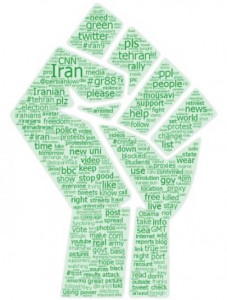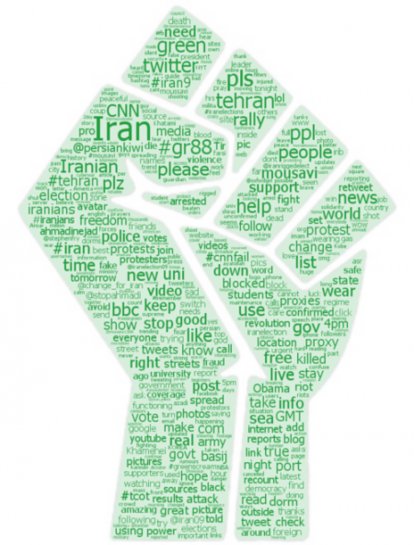“The shift in revolutionary investments corresponds with a shift in the nature of power, which has removed itself from the streets and become nomadic.” — Critical Art Ensemble artist-tacticians, Qud in Rita Raley’s Tactical Media.
Tactical Media
Enter tactical media, a resistant form of cultural production that uses networked intelligence and digital forms to create art [?] works that are political because they address power. Produced often by folks who do not care if you call it art or not – the site of the interesting part of these works is that they are interventionist, experiential, and user-oriented. Again to use the words of poet Hakim Bey, this should be “done for someone who will not know – at least for a few moments – that it is art … [and] if it does not change someone’s life, you’ve failed.†After running my shoes sticky through participatory and socially-engaged art, finding the concept and term of tactical media was refreshing, though it is not exactly a perfect fit for participatory systems of resistance, either.
Rita Raley wrote a book called Tactical Media, of which to be transparent I have only read the first 40 pages. In her introduction, she describes tactical media’s emergence as “aesthetic and critical practices that have emerged out of and in response to postindustrial society and neoliberal globalization.†That is, if information and networks are the hallmarks of the current age, they are also used as pathways to “critical intervention, dissent and resistance.â€
Raley describes the form itself as “disturbance … in the field of the symbolic,†where “signs, messages, and narratives are set into play and critical thinking becomes possible,†and I want to look closely at this definition for a moment. What else fits this? While tactical media uses digital forms and information specifically as its toolkit; narrative disturbance appears in many political art instances: feminist performance art; truthtelling/storytelling, radical relational art pieces; theatre of the oppressed; smart protest signage. Actually, a disturbance in the symbolic is an avant-garde tactic that is used with any makers’ consciousness of structuralism and semiotics. What do you think?
Tactics are not Strategies

Looking back to Thompson’s article that we read in post 1; he states that “tactics are the art of the weak…a sort of trespassing.†And suggests that using tactics as a small-scale pushback, rather than strategies, which are uses within and use traditional power, is an acceptance of defeat ahead of time, or even worse, a masturbatory and self-satisfied form of individual therapy for alienation masquerading as political art. This begs the question of who benefits, who sees, who cares.  Raley discusses this “irony that disguises co-optation†and quotes CAE as saying that their works “need not be an image of aquiesence or complicity…although such action may resemble the gestures of a drowning person,†and concludes that the important – and meaningfully possible – potentiality of tactical media is that the effects are “uncertain and unpredictable.†I’d like to name systems that have uncertain outcomes as generative, and note that we’ll disucss them later. The question at the moment is: is this accurate? If one leaves outcomes to chance, is that unprincipled and careless direct action, or is it leveraging emergent forms of networked spatiality? Does it matter what it is, except to those who experience the tactics of the media?
Who Benefits, Who Uses
Who is “using†the receiving end of the tactic. Again invoking Wright, the important question of where an art work is framed can neutralize its effectiveness as a tactic of radical education, or empower user/viewers to act, create, critique, or just watch. Raley emphasizes the radical pedagogy inherent in tactical media distributions, from shared code to FAQs, concluding that tactical media “focuses on open-ended questions rather than prepackaged lessons, instructions rather than products.” Here is where things get interesting: along with the generativity in outcome is a pedagogy that encourages building. I’m thinking of DIY and “maker†culture as much as Ranciere’s Ignorant Schoolmaster and Friere’s Pedagogy of the Oppressed here – both conceptions that one does not need to know ahead of time to learn to do something.
So, tactical media is firstly a product of both developments in digital technology and media arts. Branka ĆurÄić describes new media art broadly as “artwork that incorporates an element of new media technology,†and then immediately points out that media arts can be completely in collusion with and aligned with market-driven needs, e.g. “in service to industry.†Sholette describes how “The near-total privatization, objectification, and marketing of life seeks to incorporate even those forms of production that historically claimed to stand outside of, or against the reach of, capitalism, on both the Left and the Right†[p35] and so it’s wise to be cautious about new forms of cultural production: that which comes from the network is not necessarily radical or anything but a product of the market.
Don’t Be A T-shirt
Sholette responds to Raley in Dark Matter, criticizing her distancing tactical media practicioners from revolutionary or political aspirations, saying that to “ignore ideology is to place its absence at the center of their narrativization.†That is to say, he means that when you say God Is Dead and run around waving No Gods No Masters around and wearing an ATHEIST shirt, you’re staying a little too focused on what you don’t believe in. That said, it’s not clear that Raley specifically or tactical media artists in general are so committed to random acts of meaning-free technology art that Sholette’s claim is true.
Another criticism of tactical media is that it is elitist; eg it can only be made by those with access to complicated technology or intellectual privileges. This is true and cultural production can only be made by those with tools; whether it’s a screen, squeegee and paint or a computer program are material details. It may in fact be true that, with the advent and mass distribution of FLOSS programs [and manuals!] that digital creation is more, rather than less, accessible. A final criticism is that tactical media has an insurrectionary tendency; that is currently inscribed to mean “it is aligned with an ableist “manarchist†politic that values violent praxis and undisciplined autonomous action.†To that, we devote a later post with the caveat that it is not, in fact, one movement fully driven by anyone, insurrectionist or otherwise.
And still, we collaborate…
Finally, ĆurÄić describes “two important notions of new [digital] art practices: collaboration and change of perspective in understanding the critical potential of art today,†both leading us to integrate the new ways of seeing communities [as potential collaborators] and
Questions I have outstanding are:
- What about feeling or emotions as related to a work or experience are not being discussed?
- Why is there a separation between understandings of experiential forms of change and academic writing?
- When thinking about who is participating, what barriers come up? Is the digital divide an idea that makes sense to invoke?
Suggested Readings:
Tactical Media “Introduction: Tactical Media as Virtuosic Performanceâ€, Rita Raley, (University of Minnesota Press, 2009)
Public Netbase: Non Stop Future: New Practices in Art and Media, “New Art Practices: editorial†by Branka ĆurÄić http://nonstop-future.org/txt?tid=9b5d15a664dfd39614d041e8511af950
“Nomadic Power and Cultural Resistance,†Welcome to a World Without Borders. Critical Art Ensemble. http://www.critical-art.net/books/ted/ted2.pdf
Further Readings:
Critical Art Ensemble, Digital Resistance: Explorations in Tactical Media
Critical Art Ensemble, Electronic Civil Disobedience: And Other Unpopular Ideas, New York, Autonomedia.
De Certeau, on the “everyday rebelâ€
Â
